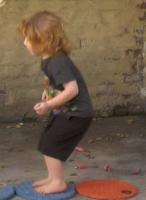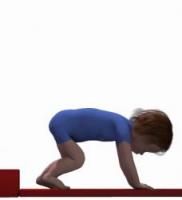A good way to increase strength, fitness and coordination
Jumping activities are a great way to improve fitness in a small space, and jumping games that are graded to match a child's fitness level, are a good way to create challenges that encourage the child to work a little harder and tolerate a bit more effort each time.
The ability to jump far or high depends on the ability to produce a rapid and powerful contraction of the hip, knee and ankle muscles just at the right time.
Performing repeated jumps also requires aerobic capacity in these muscles as well as the heart.
Children who are generally not very fit, or those with joint hypermobility (low msucle tone), DCD and autism will often avoid jumping activities because they require physical effort which leads to sensation of effort such as muscle soreness, a racing heart and labored breathing.
Development of jumping
Jumping off two feet and standing broad jumps
Young children learn to jump off two feet some in their second year. They often will initiate a jump with exaggerated bending of the knees and moving the arms backwards.

Very soon they discover how to move forwards by doing repeated jumps, taking off from, and landing on two feet.



Once they have achieved this skill they will often engage in repeated bouts of jumping just for fun.
Over time they learn to increase the distance they can jump.
Jumping over an obstacle
With practice and increasing leg muscle strength young children learn to jump over obstacles maintaining their balance on landing.
With more experience they learn to do repeated jumps over obstacles placed in a line with a gap for landing.

Jumping down
Very young children take some time before thee learn to jump down off a step.
Their first attempts involve a very quick step down leading with one leg. The rapid stepping down action creates momentum so that the child needs to control the landing in order to maintain balance.
Over time and with repeated practice the child manages to take off from 2 feet and control the landing by falling land on two feet keeping their forwards onto the hands.



Later on children learn to jump down and land without tipping forwards.
Depending on experience young children learn to jump down from a chair or sofa, as well as from higher surfaces out of doors. Initially their control of momentum when landing is poor and the child may topple forwards with minimal control. Here Max is landing on a foam block and does not hurt himself.




By fours years children who have had lots of jumping experience are able to jump down from a table or rock.

Run and jump
By 3-4 years of age children also learn to run and jump over obstacles. At first they run towards an obstacle, slow down and step over it, then continue running. But with practice they learn to run and leap over a low obstacle without breaking their stride.

Training tips
Going-for-the-burn
Children with movement difficulties, particularly those with a fearful nature, often do not like or tolerate the physical sensations that go with all-out effort. The child may think that they are a sign that something is wrong and a racing heart is associated with fear and panic.
It helps to ask the child to describe these sensations and to tell them that they are a sign that they are working hard, and that if they work hard they will get fitter. And that going-for-the-burn is a good thing.
Creating challenges
Depending on the task, children can be challenged to improve their jumping abilities by jumping higher, jumping further, or doing more jumps.
Children are usually more willing to participate in an activity when they have a sense of control over what they are expected to do. Allow your child to help you plan the activity and how you are going to measure the outcome.
Also let the child have select from two options the number of repetitions for the activity.
Training activities for subscribers
Two foot jumps for improving general fitness
Standing broad jumps between cushions
SfA Fitness and Coordination Training Guide
All the information you need to be your child's coach and advocate
Subscribe here for just $20
Disclaimer The content on this site is provided for general information purposes only and does not constitute professional advice. All liability is excluded to the fullest extent permitted by law in respect of any loss or damage whether direct, indirect or consequential that arises in connection with the use of or reliance upon any content forming part of this site.

